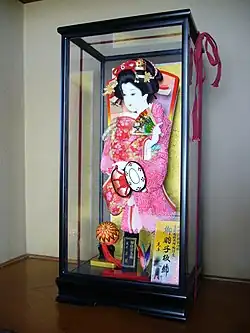羽子板
Japanese

| Kanji in this term | ||
|---|---|---|
| 羽 | 子 | 板 |
| は Grade: 2 |
こ > ご Grade: 1 |
いた Grade: 3 |
| kun’yomi | ||
Etymology
Compound of 羽子 (hago, “shuttlecock”, literally “feathered little thing”) + 板 (ita, “board”, in reference to the paddles used to hit the shuttlecock).[1][2][3]
Noun
羽子板 (hiragana はごいた, rōmaji hagoita)
- a hagoita: a rectangular wooden paddle used to play hanetsuki (traditional Japanese battledore, similar to badminton); often painted with a colorful image and used as an ornament in modern Japan: see 羽根突き (hanetsuki) for more
References
- 1988, 国語大辞典(新装版) (Kokugo Dai Jiten, Revised Edition) (in Japanese), Tōkyō: Shogakukan
- 2006, 大辞林 (Daijirin), Third Edition (in Japanese), Tōkyō: Sanseidō, →ISBN
- 1997, 新明解国語辞典 (Shin Meikai Kokugo Jiten), Fifth Edition (in Japanese), Tōkyō: Sanseidō, →ISBN
- 1998, NHK日本語発音アクセント辞典 (NHK Japanese Pronunciation Accent Dictionary) (in Japanese), Tōkyō: NHK, →ISBN
This article is issued from Wiktionary. The text is licensed under Creative Commons - Attribution - Sharealike. Additional terms may apply for the media files.